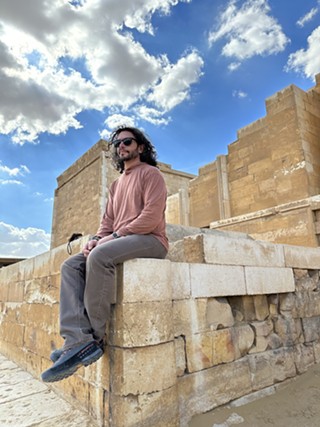It was almost dawn on a balmy night in July of 1993. Amara and I had been lying in the grass all night, talking about the future. We were college dropouts living in a spiritual community, unsure of what we would do "in the world."
The stars were bright and we identified some constellations. Following the line described by Orion's belt downward I pointed out Sirius, just as it rose above the horizon. It was as though the start itself conveyed an idea.
"We should start a magazine," I said as we looked at the dual star.
"Yes," said Amara, as though it was obvious.
We talked further, fleshing out the concept.
"The Hudson Valley is so rich with clusters of community and creativity," Amara contributed.
"It needs a calendar that lists even the smallest events and gatherings," I responded, as though engaging in a process of Socratic dialectic. "It would be a kind of esoteric calendar, for those who are in the know."
The next day we stopped by the SUNY college library and perused the mammoth Oxford English Dictionary seeking a term that matched our meaning. Chronogram—"The word," we read, "meaning 'time writing', derives from the Greek words chronos ('time') and gramma ('letter')." Perfect.
We quit our jobs and set to work. Amara designed a format and media kit and I planned editorial, canvassed organizations for calendar listings, and offered advertising space. We gave ourselves two months to conjure content and sell 10 pages of ads. If we could do it, the magazine would go forward. If not, we'd go back to our day jobs with our tails between our legs.
What qualified us to start a magazine? Nothing much other than the hubris and daring of youth. I had been a professional rock climber, a Chinese herb salesman, a writer and photographer for a local newspaper; Amara had been a painter, graphic designer, and bookstore manager.
But we had inspiration from a star, and that enthusiasm was contagious. Two months later we had sold 12 pages of ads and Chronogram was born. We rented office space and learned to roll with the punches. For instance, when the first issue came back from the printer bound horizontally instead of vertically, we decided to go with it, and used the format more like a calendar than a magazine for a few years.
In the beginning a friend who was experienced in business said "an enterprise is never mature for at least 7 years." This was hard to swallow at age 22, but after seven years, I saw something interesting happen: What had required constant effort and attention from me and Amara began to take on a life of its own. People joined us who shouldered responsibility, and fed the magazine with new talent and creativity, and the magazine's readers and advertisers began to show truly sustaining support.
Twenty years later, Chronogram has attained its majority, and has become a real force in the community, which is, for its founders a great source of pride and pleasure. Over the years, innumerable people have said the words "I didn't know how much the Hudson Valley had to offer until I read Chronogram." This was and remains precisely our purpose, and was, perhaps, what the purpose the Dog Star meant to convey.
Amara Projansky When Jason suggested we start a New Age magazine, I let the idea settle in me for a minute. I liked magazines, and I liked reading, and I liked the area, and I even liked thoughtful, New Age kind of stuff. But I realized it was going to need more content than that. I told him to count me in—but we should include arts and culture as well as the spiritual. We focused the magazine on helping people enjoy the area as much as we did. Meanwhile, I wanted it to look really good. I had studied art, but I wasn't confident or schooled in graphic design, so a few choice suggestions along the way helped me learn, and over successive issues I found the look and feel of the magazine. Stanley Kanney suggested we use the cover to showcase real art—a signature feature of Chronogram to this day. Dorothy Hamburg's eye for type was contagious and helped me find a format that was easily readable and a pleasure to peruse from the beginning. A few great designers (thank you, Anthony Kosner) gave me encouragement that what I was doing worked, despite my doubts. My five-year stint as art director for Chronogram—only one of the many hats I wore when we first began—ended, but it was the beginning of a surprise love affair with graphic design—for both me and the magazine. My shoes have been over-filled by our subsequent art directors, Molly Rubin, Carla Rozman, and David Perry, and I get a thrill seeing the beautiful development of the magazine. What started out being referred to as "that little thing" grew and grew. Now you can't miss it, (unless you forget to pick one up in the first week of the month). It just gets better and better.














